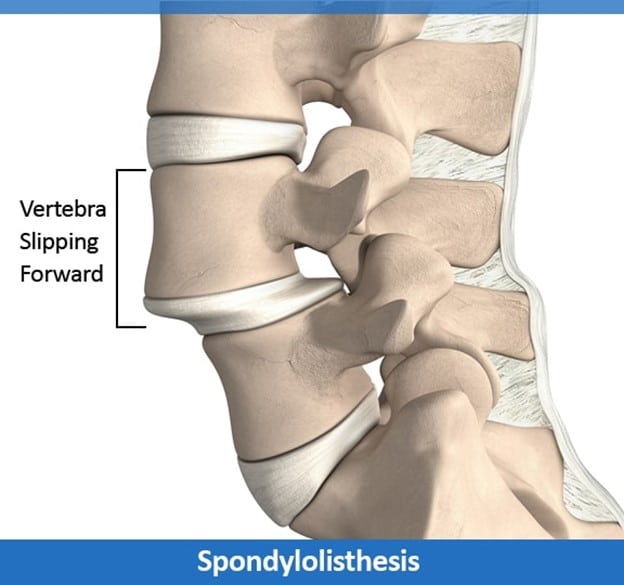Spondylolisthesis Lumbar Spine

Spondylolisthesis is a condition in which one spinal bone slips from its place and is positioned on the top of the spinal bone present next to it. It commonly happens at the spinal base or the lumbar spine and is called spondylolisthesis of the lumbar spine. When the displaced vertebra exerts pressure on any nerve, it results in pain in your legs or lower back. Often, people do not show any symptoms, but the common ones include muscle stiffness, buttocks pain, tightened hamstrings, pain that increases while moving around, etc.
Types of Spondylolisthesis lumbar spine
Spondylolisthesis has been divided into six types:
Degenerative spondylolisthesis
This type is common because of ageing. The spinal discs responsible for cushioning the vertebrae become thin and worn out, due to which the vertebra easily slips away from its place.
Isthmic Spondylolisthesis
This happens because of spondylosis. A crack causes the vertebrae to slip in backward direction or forward or over the bone elbow. It mostly affects those engaged in gymnastics and weightlifting and even football players due to repeat overextension of their back. Sometimes, it is present from the time of birth when one vertebral bone is thinner than the usual one.
Congenital spondylolisthesis
It is also called dysplastic spondylolisthesis and occurs because of improper alignment of the vertebrae due to any birth defect.
Traumatic spondylolisthesis
In this type, a spinal injury causes the vertebrae to slip out from its place.
Pathological spondylolisthesis
This occurs because of any other spinal condition, such as osteoporosis or spinal tumor.
Post-surgical spondylolisthesis
Also known as iatrogenic spondylolisthesis, it happens when any vertebra goes out of its place because of a spinal injury.
Grades of spondylolisthesis of the lumbar spine
The grades show how serious your spondylolisthesis is. One of the common types of grading system is Meyerding’s classification, which is as follows:
- Grade I: It is the commonly occurring grade where there is 1–2% of vertebral slippage.
- Grade II: Here there is 50% of vertebral slippage.
- Grade III: It involves 75% of slippage of the vertebra.
- Grade IV: Vertebral slippage is 76–100%.
- Grade V: Over 100% slippage and is called spondylosis.
While Grade I and Grade II are considered low-grade spondylolisthesis, those that are Grade III and above are higher grades.
Treatment of spondylolisthesis lumbar spine
The type of treatment you require relies on the grade of spondylolisthesis you have, as well as your age, medical history, and symptoms. Low-grade can be treated through physical therapy or appropriate medications, but for high grade, you might need surgery.
Non-surgical treatments
- Resting and time off from vigorous activities
- Medications such as anti-inflammatory medicines (e.g., naproxen or ibuprofen) for relief from pain
- Injections such as steroid shots in areas where you are experiencing pain
Surgical treatments
When you have high-grade spondylolisthesis or you are suffering from pain and disabilities even after non-surgical treatments, you might require surgery. Some surgical options are:
- Spinal decompression
It decreases the nerve pressure for relief from pain through techniques such as removing the bone from the spine, taking out part or all of the spinal disc, or making the spinal canal opening large.
- Spinal fusion
Here the surgeon will join or fuse the vertebrae that are impacted to prevent the slip.
Conclusion
Spondylolisthesis lumbar spine occurs when your vertebrae slips out from its place. This results in back pain and other different symptoms. Timely and proper treatment is important to avoid its long-term effects.
For enquiries and online appointments:
Email – Naveen.st@gmail.com
Call/Whatsapp – +91 7676090119
Visit www.NaveenSpine.com to know more




